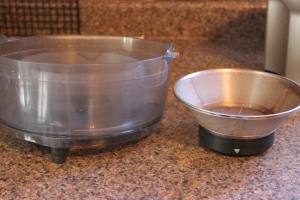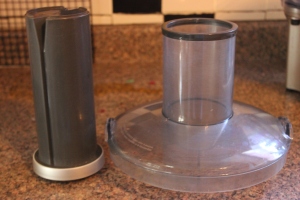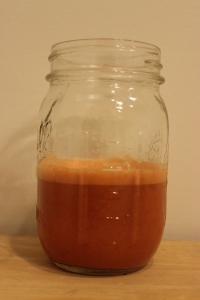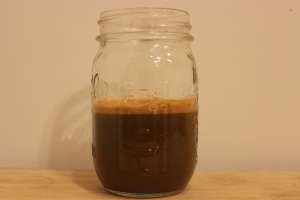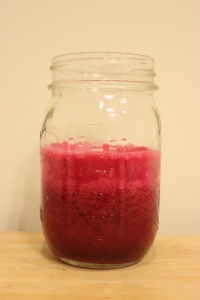What is juicing?
Being on a liquid diet I try to pack as much nutrition as possible in everything I drink. Juicing has allowed me to get the nutrients from fruits and veggies that I otherwise wouldn’t get. Some may be confused by what exactly juicing is since high quality blenders such as the Nutribullet and Vitamix claim that their product can be used for juicing. To me, anything made in a blender such as the Nutribullet and Vitamix is a smoothie not a juice. The difference between using a high quality blender and a juicer is that in a blender the whole fruit is being blended up and the fiber stays, when you use a juicer the fiber gets collected in a seperate container and only the juice is consumed. As many Gastroparesis patients know, we are all advised to have a low fiber diet to prevent worsening of symptoms and bezoars which makes it difficult to include a variety of fruits and veggies in our diet due to the high fiber content. The low amount of fiber in juices makes it a great option for those who have Gastroparesis. Even though juicing is considered GP friendly, you may not tolerate it! Everyone’s body is different. I would suggest borrowing a juicer, visiting a juice bar or buying a cheaper juicer to try out.
What are the best ingredients to juice for digestion?
Even though juicing gives you more freedom you still have to be careful with what fruits and veggies you use to juice. Many people who have Gastroparesis tend to have problems with reflux and acid problems so it’s best to stay away from acidic fruits (ex: oranges). Certain veggies can cause bloating and discomfort (ex: broccoli). Some notice that avoiding high fodmap fruits and veggies allows them to tolerate juices better. Overall some key ingredients that help with digestion include:
Ginger: This is pretty popular and is known to help relieve stomach discomfort and nausea and help increase gastric emptying. It doesn’t take much for ginger to overpower the flavor of your juice! A little goes a long way. Too much ginger can also cause heartburn and increase the risk of bleeding.
Lemon/Lime: Both help aid in digestion and can relieve nausea/vomiting. A little goes a long way in juicing as well. Avoid if you reflux, gastritis and prone to heartburn.
Pineapple: Pineapple contain bromelain which is an enzyme that helps digest food. It is known to alleviate heartburn and stomach discomfort. Pineapple is acidic so again if you have reflux, gastritis etc you should avoid it or avoid putting too much of it in your juice.
Juicing Facts & Tips
- Juice needs to be consumed immediately due to oxidation
- You can store juices in the fridge but it needs to be in a glass container filled to the brim with a top leaving no space for air
- Juices shouldn’t be kept in the fridge for longer than 24 hours
- The more time it’s spent out or in the fridge the less nutrients it will have
- Juice cannot be left out too long due to bacteria
- There will still be debris in the juice, if you can’t tolerate it you can strain it with a cheese cloth
- There are two types of juicers: masticating and centrifugal
- Masticating juicers tend to be more expensive and don’t use as much heat allowing for more nutrition
- Centrifugal juicers are more popular and inexpensive and allow bigger pieces of fruits/veggies to go through but create more heat
What juicer do I use?
I have a Breville Compact Juice Fountain. It’s a centrifugal juicer, I’ve owned it for over 2 1/2 years and still works great! I juice everyday about 2 or 3 times a day. It has five pieces (motor/stand, pulp holder, blade/filter, top and plastic piece to push fruit) and is pretty easy to clean. The pulp left behind is pretty dry so most of the juice is extracted.
What about all the waste (pulp)?
When you juice there will always be pulp left over no matter what. Some people say it’s wasteful because it’s not being consumed however there are other ways to use it! My family has a garden so we use it as compost for it. I’ve also heard of people using it to make soups with the veggie pulp and muffins with both fruit/veggie pulp.
Recipes
These recipes are good for beginners because the veggie taste isn’t overpowering and doesn’t require too many ingredients.
#1 FODMAP Friendly
- 1/2 small sweet potato
- 1 small carrot
- 1/2 inch of ginger
- 1/3 lime (optional)
makes 8 ounces
#2 FODMAP Friendly
- 1/2 of a beet
- 1 carrot
- 1 cup of grapes
makes 8 ounces
#3
- 1 apple
- 1 cup of spinach
- 2 small carrots
- 1/2 inch piece of ginger
makes 8 ounces
#4 FODMAP Friendly
- 1 cup diced pineapple
- 1/2 cup grapes
- 1/4 cup sliced zucchini
- 2 carrots
10 ounces
#5 FODMAP Friendly
- 1 cup of pineapple
- 1/2 of a beet
- 1/2 cup of grapes
- 1/4 cup of sliced sweet potato
8 ounces

